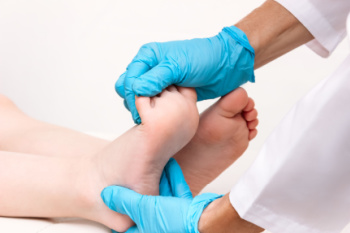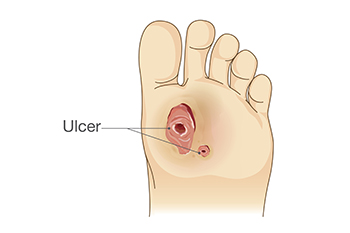Connect With Us
Blog
Items filtered by date: February 2024
How to Manage a Broken Toe

If you break your big toe, seeing a podiatrist can be helpful. This type of doctor will examine your toe to determine the extent of the injury. Depending on the severity, X-rays may be taken to see the extent of the fracture. The podiatrist can provide guidance on how to care for your broken toe properly. They can recommend resting the foot and elevating it to reduce swelling. In some cases, they may suggest buddy taping the broken toe to the adjacent one for support. If the fracture is severe or if the toe is misaligned, they may need to realign it or provide a splint to keep it in place. The podiatrist can also offer pain management techniques and advise on when it is safe to resume normal activities. If you believe you have fractured your big toe, it is suggested that you schedule an appointment with a podiatrist for a proper diagnosis and treatment that is deemed necessary.
A broken toe can be very painful and lead to complications if not properly fixed. If you have any concerns about your feet, contact Pedram Aslmand, DPM from Advanced Foot and Ankle Center. Our podiatrist will treat your foot and ankle needs.
What to Know About a Broken Toe
Although most people try to avoid foot trauma such as banging, stubbing, or dropping heavy objects on their feet, the unfortunate fact is that it is a common occurrence. Given the fact that toes are positioned in front of the feet, they typically sustain the brunt of such trauma. When trauma occurs to a toe, the result can be a painful break (fracture).
Symptoms of a Broken Toe
- Throbbing pain
- Swelling
- Bruising on the skin and toenail
- The inability to move the toe
- Toe appears crooked or disfigured
- Tingling or numbness in the toe
Generally, it is best to stay off of the injured toe with the affected foot elevated.
Severe toe fractures may be treated with a splint, cast, and in some cases, minor surgery. Due to its position and the pressure it endures with daily activity, future complications can occur if the big toe is not properly treated.
If you have any questions please feel free to contact our offices located in Long Beach, CA . We offer the newest diagnostic and treatment technologies for all your foot and ankle needs.
Are Bunions Affecting Your Everyday Life?
What Can Cause an Ingrown Toenail?

An ingrown toenail occurs when the edge of the nail grows into the surrounding skin, leading to pain, swelling, and redness. This common condition typically affects the big toe and can result from various factors. Improper nail trimming, such as cutting nails too short or rounding the edges, increases the risk of ingrown toenails by encouraging the nail to grow into the skin. Wearing tight or ill-fitting shoes can also exert pressure on the toes, causing the nail to grow abnormally and become ingrown. Additionally, injury or trauma to the toe, such as stubbing or repetitive pressure, can disrupt nail growth patterns and contribute to ingrown toenails. Individuals with curved or unusually shaped nails may be more susceptible to this condition. Poor foot hygiene and fungal infections further exacerbate the risk of ingrown toenails. If you have symptoms of an ingrown toenail, it is suggested that you schedule an appointment with a podiatrist who can properly diagnose this condition, and offer appropriate treatment solutions.
Ingrown toenails can become painful if they are not treated properly. For more information about ingrown toenails, contact Pedram Aslmand, DPM of Advanced Foot and Ankle Center. Our podiatrist can provide the care you need to keep you pain-free and on your feet.
Ingrown Toenails
Ingrown toenails occur when a toenail grows sideways into the bed of the nail, causing pain, swelling, and possibly infection.
Causes
- Bacterial infections
- Improper nail cutting such as cutting it too short or not straight across
- Trauma to the toe, such as stubbing, which causes the nail to grow back irregularly
- Ill-fitting shoes that bunch the toes too close together
- Genetic predisposition
Prevention
Because ingrown toenails are not something found outside of shoe-wearing cultures, going barefoot as often as possible will decrease the likeliness of developing ingrown toenails. Wearing proper fitting shoes and using proper cutting techniques will also help decrease your risk of developing ingrown toenails.
Treatment
Ingrown toenails are a very treatable foot condition. In minor cases, soaking the affected area in salt or antibacterial soaps will not only help with the ingrown nail itself, but also help prevent any infections from occurring. In more severe cases, surgery is an option. In either case, speaking to your podiatrist about this condition will help you get a better understanding of specific treatment options that are right for you.
If you have any questions please feel free to contact our offices located in Long Beach, CA . We offer the newest diagnostic and treatment technologies for all your foot and ankle needs.
Common Conditions Affecting Children’s Feet

Children can develop various foot conditions like adults, including plantar warts, flat feet, heel pain, and ingrown toenails. However, these issues can have unique characteristics in children due to their growing bodies and active lifestyles. Normal bone and muscle growth changes in the legs during childhood can contribute to heel pain and flat feet. Additionally, children's active nature can lead to common problems like ingrown toenails and warts, often worsened by wearing tight-fitting shoes during growth spurts. Ingrown toenails can affect people of all ages but are prevalent among teenagers, possibly due to ill-fitting footwear, and resulting in infected ingrown toenails causing the skin to become red, swollen, and warm. Plantar warts, caused by a virus, often appear in children and young adults, resembling circular, thickened skin with tiny black dots. Flat feet, or pes planus, are common among children, generally resolving naturally but manageable with orthotics or arch supports to control pronation. Heel pain in children often relates to plantar fasciitis or Sever's disease, triggered by tight calf muscles and Achilles tendons during growth spurts. If your child has foot problems, it is suggested that you schedule an appointment with a podiatrist for a proper diagnosis and appropriate treatment for their situation. Early identification is important in ensuring children have healthy and pain-free feet as they grow and develop.
The health of a child’s feet is vital to their overall well-being. If you have any questions regarding foot health, contact Pedram Aslmand, DPM of Advanced Foot and Ankle Center. Our podiatrist can provide the care you need to keep you pain-free and on your feet.
Tips for Keeping Children's Feet Healthy
- Make sure their shoes fit properly
- Look for any signs of in-toeing or out-toeing
- Check to see if they have Clubfoot (condition that affects your child’s foot and ankle, twisting the heel and toes inward) which is one of the most common nonmajor birth defects.
- Lightly cover your baby’s feet (Tight covers may keep your baby from moving their feet freely, and could prevent normal development)
- Allow your toddler to go shoeless (Shoes can be restricting for a young child’s foot)
- Cut toenails straight across to avoid ingrown toenails
- Keep your child’s foot clean and dry
- Cover cuts and scrapes. Wash any scratches with soap and water and cover them with a bandage until they’ve healed.
If you have any questions, please feel free to contact our offices located in Long Beach, CA . We offer the newest diagnostic and treatment technologies for all your foot care needs.
How Podiatrists Manage Diabetic Feet
 Podiatrists play a vital role in diabetic foot care, offering specialized assistance to prevent foot complications from developing. People with diabetes need to pay close attention to foot care, because high blood sugar can cause damage to nerves and result in poor blood circulation in the feet. When people cannot feel pain in their feet, they may not notice problems such as cuts and ulcers. Wounds are at even higher risk for infection as a result of poor blood flow. Podiatrists help by conducting regular foot exams to identify any issues early on. They also perform neurovascular and musculoskeletal assessments for the feet. Podiatrists educate their patients about proper foot hygiene, nail care, and daily foot checks, as well as recommend suitable footwear to prevent problems. If a patient has foot issues such as calluses, corns, or ingrown toenails, this type of doctor can treat them to prevent the issues from worsening. If you have diabetes and suspect foot problems, it is suggested you consult a podiatrist who can help you manage and prevent foot-related complications due to having diabetes.
Podiatrists play a vital role in diabetic foot care, offering specialized assistance to prevent foot complications from developing. People with diabetes need to pay close attention to foot care, because high blood sugar can cause damage to nerves and result in poor blood circulation in the feet. When people cannot feel pain in their feet, they may not notice problems such as cuts and ulcers. Wounds are at even higher risk for infection as a result of poor blood flow. Podiatrists help by conducting regular foot exams to identify any issues early on. They also perform neurovascular and musculoskeletal assessments for the feet. Podiatrists educate their patients about proper foot hygiene, nail care, and daily foot checks, as well as recommend suitable footwear to prevent problems. If a patient has foot issues such as calluses, corns, or ingrown toenails, this type of doctor can treat them to prevent the issues from worsening. If you have diabetes and suspect foot problems, it is suggested you consult a podiatrist who can help you manage and prevent foot-related complications due to having diabetes.
Diabetic foot care is important in preventing foot ailments such as ulcers. If you are suffering from diabetes or have any other concerns about your feet, contact Pedram Aslmand, DPM from Advanced Foot and Ankle Center. Our podiatrist can provide the care you need to keep you pain-free and on your feet.
Diabetic Foot Care
Diabetes affects millions of people every year. The condition can damage blood vessels in many parts of the body, especially the feet. Because of this, taking care of your feet is essential if you have diabetes, and having a podiatrist help monitor your foot health is highly recommended.
The Importance of Caring for Your Feet
- Routinely inspect your feet for bruises or sores.
- Wear socks that fit your feet comfortably.
- Wear comfortable shoes that provide adequate support.
Patients with diabetes should have their doctor monitor their blood levels, as blood sugar levels play such a huge role in diabetic care. Monitoring these levels on a regular basis is highly advised.
It is always best to inform your healthcare professional of any concerns you may have regarding your feet, especially for diabetic patients. Early treatment and routine foot examinations are keys to maintaining proper health, especially because severe complications can arise if proper treatment is not applied.
If you have any questions please feel free to contact our offices located in Long Beach, CA . We offer the newest diagnostic and treatment technologies for all your foot and ankle needs.

